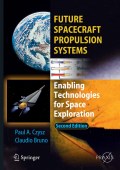
Future spacecraft propulsion systems: enabling technologies for space exploration
Czysz, P.A.
Bruno, C.
In this second edition of Future Spacecraft Propulsion Systems, the authors demonstrate the need to break free from the old established concepts of expendable rockets, using chemical propulsion, and to develop new breeds of launch vehicle capable of both launching payloads into orbit at a dramatically reduced cost and for sustained operations in low-Earth orbit. The next steps to establishing a permanent ‘presence’ in the Solar System beyond Earth are the commercialisation of sustained operations on the Moon and the development of advancednuclear or high-energy space propulsion systems for Solar System exploration out to the boundary of interstellar space. In the future, high-energy particleresearch facilities may one day yield a very high-energy propulsion system that will take us to the nearby stars, or even beyond. Space is not quiet: it isa continuous series of nuclear explosions that provide the material for new star systems to form and provide the challenge to explore. Updates and expands the information in the first edition of Future Spacecraft Propulsion Systems Includes new material on fusion propulsion Puts spacecraft propulsion in perspective, from earth orbit launchers to astronomical/space exploration vehicles Demonstrates the logical expansion of propulsion concepts Looks at the design limitations imposed by the mission requirements INDICE: Commercial Proximate Earth Launcher.- On-orbit Operations in Proximate Earth Orbit.- Earth-Moon System Advantages.- The Need for Nuclear or HighEnergy Space Propulsion.- The Need for Very High Energy Space Propulsion.- The Need for Light Speed Plus Propulsion.
- ISBN: 978-3-540-88813-0
- Editorial: Springer
- Encuadernacion: Cartoné
- Páginas: 496
- Fecha Publicación: 01/11/2008
- Nº Volúmenes: 1
- Idioma: Inglés
